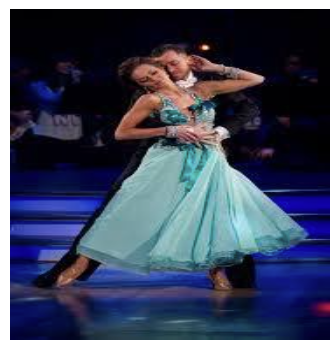Waltz Dance

DANCE HISTORY
One of the oldest ballroom dance is the Waltz. Dating from the middle of the Eighteenth Century. The original form of Waltz was first used by 13th century peasants in Germany, who devised rolling folk dance that was quite different from all court dances that were popular in that time. Their folk dance filled with rolls, glides and turns was received well, and by 1500s it reached Volta where it was adapted with styles of other local dances. By the end of 16th century people of Vienna embraced Waltz and morphed it into dance called Weller, and France used form called Nizzarda.
Before the creation of the modern form of waltz, all court dances were rigid, stately, solemn, procession-based, very tightly controlled, with complicated moves and timings. Waltz changed that with the introduction of free form dance with close position of dances, which immediately sparked revolt and scandals from traditional lovers of old ballroom dance.
The German “Lander”, a folk dance, is supposed to be the forerunner of the Waltz. During this time period a dance developed which was called the “Walzer”, a word owing its origin to the Latin word Volvere, which indicates a rotating motion.
The first Introduction of the Waltz into the ballroom of the world in the early years of the Nineteenth century, met with outraged indignation, for it was the first dance where the couple danced in a modified Closed Position – with the man’s hand around the waist of the lady.
BALLROOM DANCE SCENE
Waltz is the dance that comes to mind when ballroom dance is mentioned. However, there is a significant difference between the ballroom dancing waltz and various other ballroom dances.
Waltz dance, happens to be a ballroom dance performed in three quarters of time. Originally, the history of ballroom dancing waltz, the ‘queen of all dances’, dates back to 13th century in Germany to a really simple form.
The exact form of ballroom dancing waltz can be traced in Vienna, Austria’s alpine region when peasantry of Bavaria and Austria were dancing in the early years of 17th century. It was only quite later that the waltz made its presence felt in the various ballrooms of Vienna’s Hapsburg court. All dances commonly performed during this part of the century were stately and quite solemn. Dances involving touching, especially in public, were regarded immoral and sinful and were not allowed for general public except the prostitutes. No wonder, until this time, waltz was considered as scandalous since it was performed in a close position. During the middle 18th century, France saw growing popularity of the Allemande, a form of waltz. Although initially, this was performed with arms intertwined at shoulder levels. However, later on, the waltz took the form of an independent dance. It was in the late 18th century that the waltz was recognized and approved by high-strata people and the dance was here to stay in the Ballroom dance sport.
DANCE CLASS
Learning to dance the waltz dance, shouldn’t be restricted to when you are planning to get married. However, whether you are planning to get married or just want to learn the ballroom dancing for other reasons, having a good knowledge of waltz dance is just an excellent idea.
Before you can learn to dance the waltz, you first need to decide whether you want to learn both types of waltz dance such as the English/modern waltz and the Viennese waltz or just one.
The English version is a slow dance, while the Viennese version is quite fast. Both are very adaptable dance and can easily be modified to fit many types of background music.
If you want to learn how to dance the waltz, you could start by hiring a qualified dancing instructor. A good instructor can teach you all the finer points of the dance. Just be sure that they are experienced in teaching the waltz.
As a beginner, other ways you can learn how to dance the waltz include instructional videos, which you can get online or in stores, and by going to parties where people are doing the waltz and observing them.
Instructional videos helps you learn at your own pace, while parties are good place where you can see the waltz performed right in front of you and possibly even find someone willing to help you. You might also try learning to dance the waltz in a dance studio with professionals who are there to help you. If you go to the studio regularly, you can not only learn the steps, but really become comfortable with them.
